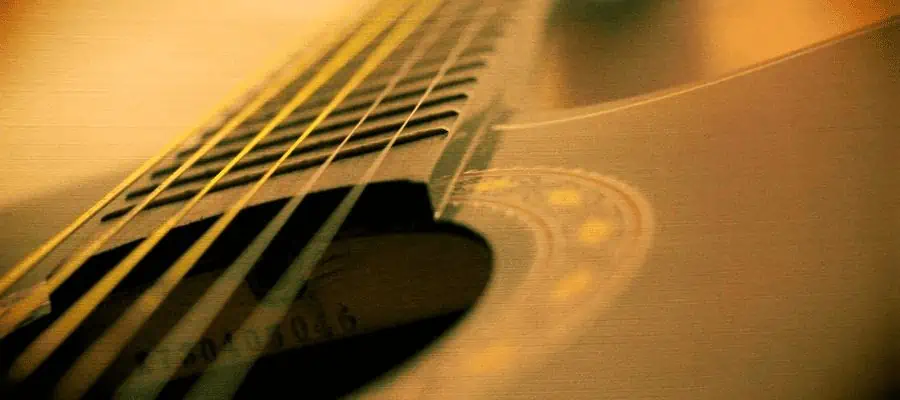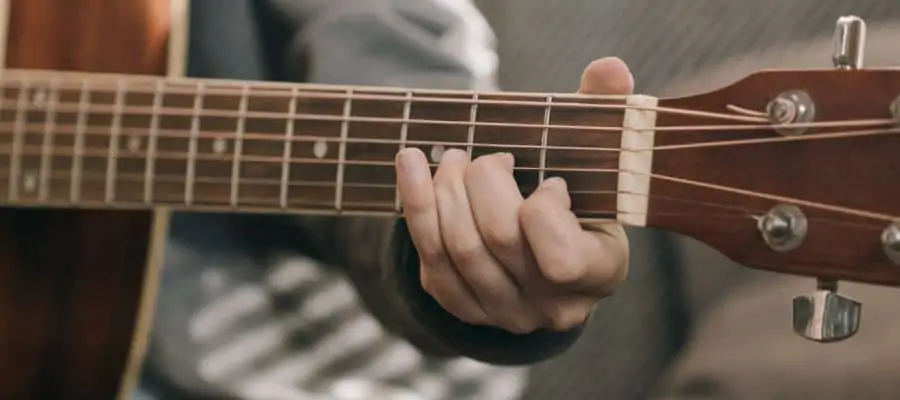When you pick up a guitar and press down on steel strings, the experience might be pretty painful, especially if you are new to playing. It is a process that every player goes through when they start playing acoustic or electric guitar. But initially, you might wonder if the pain is a necessary part of the learning process or if there is a way to mitigate it.
The steel strings exert pressure, cause friction, and generally create tension against your fingertips. Over time, with consistent practice, your fingers will develop calluses that provide a natural barrier against the discomfort.
To understand why this occurs, it’s essential to consider the physical demand playing the guitar places on your fingertips. Unlike nylon strings, steel strings are tougher and sharper, which can lead to soreness, particularly when pressed against metal frets. Soreness is a natural response as you train the delicate skin on your fingertips to endure more than it’s accustomed to.
However, there are measures to alleviate this soreness and prevent it from escalating into a more serious issue. Utilizing lighter gauge strings, adjusting your playing technique, and allowing proper rest for your fingers can help manage the initial discomfort. It’s also vital to recognize when to take a break because continually playing with sore fingers can exacerbate the issue, potentially leading to longer-term damage to your soft tissues.
Understanding Steel Guitar Strings

When you’re strumming away or picking out a melody, the type of strings on your guitar plays a crucial role in both the sound produced and how your fingers feel during and after playing. Steel strings are known for their bright, crisp sound, but they can be harsh on your fingers, especially when you’re just starting out or during extended playing sessions.
Material and Construction
Steel strings are crafted predominantly from various metals, contributing to their durability and characteristic tone. The core wire is usually made from steel and often wrapped with other metals such as bronze, brass, or nickel. These materials are chosen for their sound quality and withstand the tension and stress of tuning and playing.
- Core: Steel
- Winding Material Options:
- Bronze
- Brass
- Nickel
Tension and Gauge
The tension of a guitar string refers to the force exerted by the string when it is tuned to pitch. Steel strings typically have higher tension compared to their nylon counterparts. The gauge, or thickness, of the strings, also plays a significant role in how much they will hurt your fingers. Thicker, heavier strings (higher gauge) produce more tension and require more finger pressure to fret and play.
| String Gauge | Description |
| Light | Easier on the fingers |
| Medium | Standard tension |
| Heavy | Higher tension, harder to press down |
Remember, opting for lighter gauge strings can mean less finger pain as you’re building up calluses.
Playing Technique and Comfort

When you begin playing the guitar, it’s common to experience finger discomfort, especially with steel strings. How you play can significantly impact how your fingers feel, and over time, you can build resilience and comfort at your fingertips. Let’s explore how to cultivate a playing technique that reduces discomfort and helps you enjoy your guitar practice more.
Finger Picking Styles
Your approach to picking can alleviate some of the stress on your fingers. For instance:
- Flat Picking: Using a pick reduces the direct pressure on your fingertips.
- Fingerstyle: Alternate between fingertips to distribute playing time and pressure.
Experiment with different styles to find what works best for you and gives your fingers a rest.
Callus Development
Calluses are the natural protection that your skin develops after being subjected to pressure and friction. When you see your fingertips developing blisters, stop playing for around a week and let the blisters turn into calluses. When you have the calluses, it is time to return to playing. And you will see that they don’t hurt anymore.
Fact: Regular play builds calluses and provides natural protection for your fingertips. Here’s a quick timeline for callus development:
- Week 1-2: Initial tenderness and redness.
- Week 3-4: Beginnings of callus formation.
- Month 2+: Full callus development, less pain while playing.
Remember, consistency is key—regular short sessions are more effective than infrequent long ones.
Tips for Reducing Discomfort
You can take steps to lessen finger pain:
- Action Adjustment: Lower the strings closer to the fretboard to require less force.
- Finger Exercises: Stretch and strengthen fingers to improve resilience.
- Short Sessions: Take frequent breaks to avoid overstraining your fingertips.
- Use hand cream: You can use a hand moisturizer cream to protect your fingertips and ease the soreness and pain.
Adopting these tips can help make your practice sessions more comfortable and productive.
Conclusion
Encountering finger pain when you play guitar strings, particularly steel ones, is a common experience that eases over time. The discomfort is due to the pressure and friction against your fingertips, which can cause soreness and blisters. Don’t be discouraged; this is just your body adjusting to a new activity. Over time, with consistent practice, your fingers will develop calluses, making playing much more comfortable.
To mitigate pain in the early stages:
- Limit initial playing sessions and gradually increase the duration
- Ensure correct technique to reduce unnecessary pressure
- Use products designed to soothe sore fingers, though they are only temporary solutions
Remember, pushing through severe pain isn’t recommended. It’s okay to take short breaks to allow healing. With patience and regular practice, you’ll be strumming away with far less discomfort before you know it.
If you found this article useful, you may want to save this pin below to your Guitar board.

Recent Posts
Some guitarists insist on buying an expensive amplifier with their electric guitar. They assume that this is a must for every type of guitarist out there. However, in some situations, this isn’t...
Top 50 Free Realistic Guitar VST Plugins With Sound Examples
As technology has rapidly advanced in the recent decade, computers are stealing more and more roles from physical musical instruments and accessories. Nowadays, you do not need expensive amps,...

